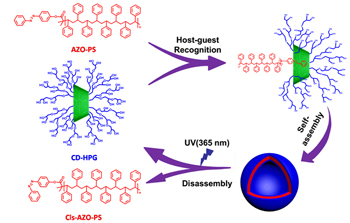| [1] Yang, S. K.; Ambade, A. V.; Weck, M. Chem. Soc. Rev. 2011, 40, 129.
[2] Brunsveld, L.; Folmer, B. J. B.; Meijer, E. W.; Sijbesma, R. P. Chem. Rev. 2001, 101, 4071.
[3] Aida, T.; Meijer, E. W.; Stupp, S. I. Science 2012, 335, 813.
[4] Appel, E. A.; del Barrio, J.; Loh, X. J.; Scherman, O. A. Chem. Soc. Rev. 2012, 41, 6195.
[5] Hofmeier, H.; Schubert, U. S. Chem. Soc. Rev. 2004, 33, 373.
[6] Chen, G.-S.; Jiang, M. Chem. Soc. Rev. 2011, 40, 2254.
[7] Yan, X.-Z.; Wang, F.; Zheng, B.; Huang, F.-H. Chem. Soc. Rev. 2012, 41, 6042.
[8] Wang, Q.; Cheng, M.; Cao, Y.-H.; Jiang, J.-L.; Wang, L.-Y. Acta Chim. Sinica 2016, 74, 9. (王其, 程明, 曹逸涵, 强琚莉, 王乐勇, 化学学报, 2016, 74, 9.)
[9] Yi, J.-M.; Xiao, X.; Zhang, Y.-Q.; Xue, S.-F.; Tao, Z.; Zhang, J.-X. Acta Chim. Sinica 2014, 72, 949. (易君明, 肖欣, 张云黔, 薛赛凤, 陶朱, 张建新, 化学学报, 2014, 72, 949.)
[10] Zhang, M.-M.; Xu, D.-H.; Yan, X.-Z.; Chen, J.-Z.; Dong, S.-Y.; Zheng, B.; Huang, F.-H. Angew. Chem., Int. Ed. 2012, 51, 7011.
[11] Yan, X.-Z.; Xu, D.-H.; Chi, X.-D.; Chen, J.-Z.; Dong, S.-Y.; Ding, X.; Yu, Y.-H.; Huang, F.-H. Adv. Mater. 2012, 24, 362.
[12] Wang, D.-L.; Chen, H.-Y.; Su, Y.; Qiu, F.; Zhu, L.-J.; Huan, X.-Y.; Zhu, B.-S.; Yan, D.-Y.; Guo, F.-L.; Zhu, X.-Y. Polym. Chem. 2013, 4, 85.
[13] Zheng, B.; Wang, F.; Dong, S.-Y.; Huang, F.-H. Chem. Soc. Rev. 2012, 41, 1621.
[14] Zhang, H.-T.; Fan, X.-D.; Suo, R.-T.; Li, H.; Yang, Z.; Zhang, W.-B.; Bai, Y.; Yao, H.; Tian, W. Chem. Commun. 2015, 51, 15366.
[15] Tao, W.; Liu, Y.; Jiang, B.-B.; Yu, S.-R.; Huang, W.; Zhou, Y.-F.; Yan, D.-Y. J. Am. Chem. Soc. 2012, 134, 762.
[16] Liu, Y.; Yu, C.-Y.; Jin, H.-B.; Jiang, B.-B.; Zhu, X.-Y.; Zhou, Y.-F.; Lu, Z.-Y.; Yan D.-Y. J. Am. Chem. Soc. 2013, 135, 4765.
[17] Dong, R.-J.; Zhou, Y.-F.; Zhu, X.-Y. Acc. Chem. Res. 2014, 47, 2006.
[18] Wurm, F.; Frey, H. Prog. Polym. Sci. 2011, 36, 1.
[19] Kricheldorf, H. R.; Stukenbrock, T. J. Polym. Sci., Part A: Polym. Chem. 1998, 36, 31.
[20] Istratov, V.; Kautz, H.; Kim, Y. K.; Schubert, R.; Frey, H. Tetrahedron 2003, 59, 4017.
[21] Barriau, E.; Marcos, A. G.; Kautz, H.; Frey, H. Macromol. Rapid Commun. 2005, 26, 862.
[22] Wurm, F.; Nieberle, J.; Frey, H. Macromolecules 2008, 41, 1184.
[23] Jiang, W.-F.; Chen, J.-X.; Yu, S.-R.; Zhou, Y.-F.; Yan, D.-Y. Acta Polymerica Sinica 2014, (10), 1398. (江文峰, 陈建新, 吁松瑞, 周永丰, 颜德岳, 高分子学报, 2014, (10), 1398.)
[24] Chou, T. M.; Prayoonthong, P.; Aitouchen, A.; Libera, M. Polymer. 2002, 43, 2085.
[25] Zhang, D. P.; Fan, Y. J.; Li, H. M.; Li, K.; Yao, Y.; Zhou, Y. F.; Yan, D. Y. RSC Adv. 2015, 5, 47762.
[26] Crupi, V.; Ficarra, R.; Guardo, M.; Majolino, D.; Stancanelli, R.; Venuti, V. J. Pharm. Biomed. Anal. 2007, 44, 110.
[27] Rekharsky, M. V.; Inoue, Y. Chem. Rev. 1998, 98, 1875.
[28] Dong, R.-J.; Zhu, B.-S.; Zhou, Y.-F.; Yan, D.-Y.; Zhu, X.-Y. Polym. Chem. 2013, 4, 912.
[29] Zhang, D.-P. M.S. Thesis, Shanghai Jiao Tong University, Shanghai, 2015. (张大朋, 硕士论文, 上海交通大学, 上海, 2015.) |
